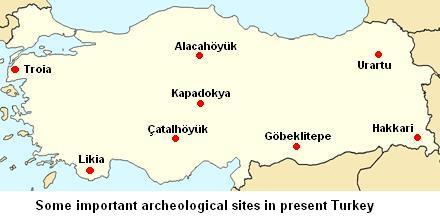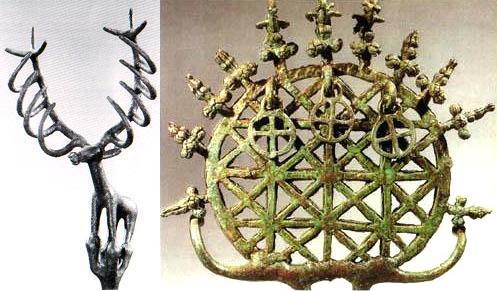|
Anatolia (present Turkey) has been a center of civilization
throughout the ages. Recently an important Neolithic site has
been discovered at Göbeklitepe (see map below). This is the
oldest site discovered so far in Anatolia. Until recent times
Jerico in Palestine and Çatalhöyük in Turkey were thought to
be the places where civilization flourished. But at
Göbeklitepe, which has been dated to about 11,000 years BP,
several circular and concentric walls within which T-shaped
monolithic pillars that are up to 3 meters high have been
unearthed.

Below
left we see the excavation going on at Göbeklitepe. The
central drawing has been executed by the German archeologist
Klaus Schmidt who is presently conducting the digs. We find a
striking similarity between these cult temples and the
Onkh / Khno sign found
allover the world (see Chapter 6,
Universal Symbols).
The drawing is a top view of the cult temple. On some of the
T-shaped pillars there are carvings of sacred animals in
relief.

Another
important antique region in the center of Turkey is known as
Cappadocia, where many dwellings have been carved into the
soft natural formations (picture below left). The shelters
have not only been carved above the earth but also several
underground cities, made out of several stages and many rooms,
have been discovered in the region. One important underground
city is found at Derinkuyu, whose vertical-cut drawing can be
seen at the center image below. On the right we see the
On-Okh symbols painted
on the walls of the rock-cut shelters of Cappadocia. They are
assumed to be drawn by the early Christian settlers. But in
fact they were there long before the arrival of the
Christians. We now can see the correlation and similarity of
these wall-paintings to the symbols of the sun worshippers.
When
Christians arrived at Cappadocia the dwellings were not empty.
They were occupied by people worshiping the sun-god. The early
Christians painted frescoes and icons on the walls of rock-cut
rooms which became to be used as primitive churches. This
approach to religion did no suit the sun worshippers and a
clash among these opposing beliefs influenced the iconoclast
period, which was a period where the icons were erased from
the walls of the early churches. In spite of the iconoclast
period many frescoes still remain to be seen on the walls of
Cappadocia.

The
similarity between the On-Okh
symbols of Cappadocia (right) and the remains of the temple at
Göbeklitepe is worth pondering. We see that both are circular
-as a symbol of the sun- with an opening to be used as an
entrance inside which a + sign or a T shaped pillar represent
the shaman leader Okh person (see Chapter 6,
Universal symbols).
The name of
the region is also worth investigating. Cappadocia can be
dissected as Cappa-d-oc-ia.
Cappa, written as “kapa”, means “close” in Turkish. The
Etruscans named their dwellings “capua” and “cabanne” means a
small hut, in French. There is an ancient Etruscan city in
Italy whose name is Capua. The word standing for head covering
in Latin was “cappa” and it changed to “capelli” in Italian,
“chapeau” in French and “cap” in English. The same word is
found as “kap” (container), “kapý” (door), “kapak” (cover) and
“kalpak” (hat) in Turkish. From these correlations we can now
elucidate Cappadocia meaning: “The
covered (closed) dwellings of the Oc people”. This
explanation is in good accordance with the underground cities
found in the region.
Another
interesting region of Anatolia is the settlements of the early
Hattians followed by the Hittites. These civilizations
flourished in the vicinity of Alacahöyük (see map at the top).
The Hatti civilization lasted from 2500 BC to 1700 BC and the
Hittites lasted from 1700 BC to 1190 BC. Regarding the Hattian
language Ekrem Akurgal says:
It has been established that
Hattian was a language peculiar to itself, completely
different from Indo-European and Semitic languages.
(1)
The Hittites
were greatly influenced by the Hattians in religion,
mythology, ceremonies and customs. Of Hattian origin was the
Sun Goddess of the Hittites. Many artifacts representing the
sun have been found in the region. There are cult symbols
belonging to the Hattians that strongly support their Asiatic
origin. The bronze stag seen below is about half a meter high
and was found in Alacahöyük. It is presently exhibited at the
Museum of Anatolian Civilizations in Ankara. The Hattian stag
has been dated to be minimum 4,000 years old. The overgrown
long horns of the stag are another indication of their Asiatic
origin (see Chapter 4, The
Asiatic Scythians).
Next to the
stag we see a religious standard of the Hattians, again dated
from 2100-2000 BC (2). Regarding this artifact E. Akurgal
gives the following explanation:
The circles here and in many
other examples symbolize the heavens. The pair of horns
symbolizes those of “the ox who carries the world upon his
horns”.
In fact, the horns are symbols of the Okh person and the
circle represents the sun. Three Onkh symbols can clearly be
seen hanging on the cult standard. The striking similarity
between Okh
and Ox
–being no other than Ochs- cannot be pure coincidence. The
corresponding word in Turkish for ox is: Oekuez, where the O,
k and z are relics still remaining from the root word
Okhs. We find
Ukhsa in Sanskrit and
Ohso in Old High
German, both words meaning Ox.
The origin of all these words is most probably the
Proto-language of Asia.
There is
also a river in central Asia originating from the Pamir
Mountains and ending at the Aral Lake, whose ancient name was
Oxus. Its present name is Amu Derya. With the interchange of
–us to “su” we obtain a meaningful Turkish word in the form of
Ok-su, which means “the Ok waterway”. There are similar named
rivers in Turkey, Aksu and Göksu being two such examples.

From these
cultural and linguistic relations we can deduce that the Oc
tribes coming from Central Asia were the early settlers of
Anatolia. |